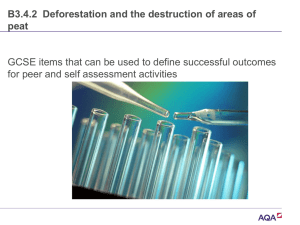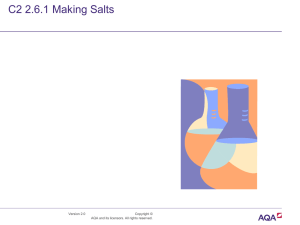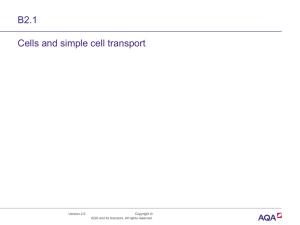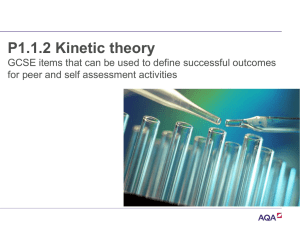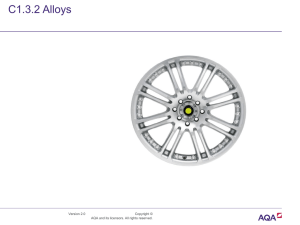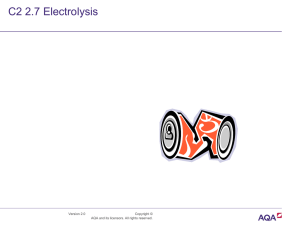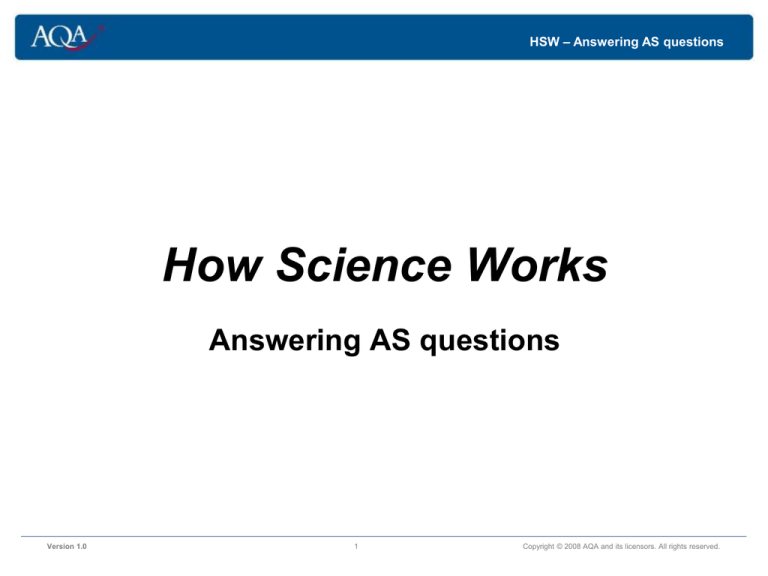
HSW – Answering AS questions
How Science Works
Answering AS questions
Version 1.0
1
Copyright © 2008 AQA and its licensors. All rights reserved.
HSW – Answering AS questions
What have mosquitoes to
do with your specification?
Look at the Assessment Objectives
AO2 Application of knowledge and
understanding of science and of How
Science Works
Candidates should be able to:
• apply scientific knowledge …to unfamiliar situations
Version 1.0
2
Copyright © 2008 AQA and its licensors. All rights reserved.
HSW – Answering AS questions
What have mosquitoes to
do with your specification?
Look at the Assessment Objectives (p46)
AO3 How Science Works
Candidates should be able to
• analyse, interpret, explain and evaluate the methodology,
results and impact of … others’ experimental and
investigative activities.
Version 1.0
3
Copyright © 2008 AQA and its licensors. All rights reserved.
HSW – Answering AS questions
What this means to you
Your examiners must test these assessment objectives.
Therefore your Unit tests must include
• Opportunities for you to apply your knowledge to unfamiliar
situations
• Examples of others’ experimental and investigative activities for
you to analyse, interpret, explain and evaluate
Version 1.0
4
Copyright © 2008 AQA and its licensors. All rights reserved.
HSW – Answering AS questions
Read the introduction to the question
• Mosquitoes are insects
• Some female mosquitoes feed on human blood.
• They are attracted to humans and land on exposed skin.
• They then pierce the host’s skin and suck blood.
The introduction may provide you with information that you will
need later.
Version 1.0
5
Copyright © 2008 AQA and its licensors. All rights reserved.
Title of presentation
A simple start
The first parts of most longer questions are often quite simple.
Examiners appreciate that giving you something that is easy at the start
gives you confidence.
1
Both of these traps used heat and carbon dioxide to attract
mosquitoes.
Explain how each of these might attract a mosquito to a human.
(a) Heat
(b) carbon dioxide
Remember, the only reason that a question looks simple is because
it is simple. No one is trying to trick you.
Version 1.0
6
Copyright © 2008 AQA and its licensors. All rights reserved.
HSW – Answering AS questions
Looking at other people’s investigations
What were the scientists investigating?
• Start by identifying the dependent and independent
variables
• Put them in this simple template.
The effect of [the independent variable] on the
[dependent variable]
• In this case . . .
The effect of [the type of trap] on the [number of
mosquitoes caught]
Having a clear idea what the investigation is about is an
essential first step towards understanding any
investigation.
Version 1.0
7
Copyright © 2008 AQA and its licensors. All rights reserved.
HSW – Answering AS questions
Looking at other people’s investigations
• Take time to make sure that you understand
exactly what they did.
The scientists moved the traps randomly between 12
different sites over 12 nights. Each night the traps were at
a different site.
12 different sites
Sometimes a
simple drawing
helps
Version 1.0
8
Copyright © 2008 AQA and its licensors. All rights reserved.
HSW – Answering AS questions
Looking at other people’s investigations
• Take time to make sure that you understand
exactly what they did.
The scientists moved the traps randomly between 12
different sites over 12 nights. Each night the traps were at
a different site.
Trap A
Night 1
Trap B
Sometimes a
simple drawing
helps
Version 1.0
9
Copyright © 2008 AQA and its licensors. All rights reserved.
HSW – Answering AS questions
Looking at other people’s investigations
• Take time to make sure that you understand
exactly what they did.
The scientists moved the traps randomly between 12
different sites over 12 nights. Each night the traps were at
a different site.
Night 2
Sometimes a
simple drawing
helps
Version 1.0
Trap A
Trap B
10
Copyright © 2008 AQA and its licensors. All rights reserved.
HSW – Answering AS questions
Looking at other tables
• Read the stem of the question.
• Make sure that you know what the table headings mean.
• Check that you understand what the table as a whole is
telling you.
Trap A
Trap B
3707
(±604)
2037
(±480)
Total number of species of mosquito trapped
17
18
Percentage of mosquitoes able to transmit Ross River
fever from one person to another
47
43
Mean number of mosquitoes trapped per night (±
standard deviation)
Here you only need to make sure that you know what the
table headings mean
Version 1.0
11
Copyright © 2008 AQA and its licensors. All rights reserved.
HSW – Answering AS questions
Check the headings
• Mean tells us
the average –
the total
number of
mosquitoes
caught
divided by the
number of
nights.
• Standard
deviation is a
measure of
how spread
out the results
were.
Version 1.0
Trap A
Trap B
Mean number of
mosquitoes trapped
per night (± standard
deviation)
3707
(±604)
2037
(±480)
Total number of
species of mosquito
trapped
17
18
Percentage of
mosquitoes able to
transmit Ross River
fever from one
person to another
47
43
12
Copyright © 2008 AQA and its licensors. All rights reserved.
HSW – Answering AS questions
Looking at tables
Total number of
species of
mosquito
trapped is quite
straightforward
Version 1.0
Trap A
Trap B
Mean number of
mosquitoes trapped
per night (± standard
deviation)
3707
(±604)
2037
(±480)
Total number of
species of mosquito
trapped
17
18
Percentage of
mosquitoes able to
transmit Ross River
fever from one
person to another
47
43
13
Copyright © 2008 AQA and its licensors. All rights reserved.
HSW – Answering AS questions
Looking at tables
There are two
things to note here.
• The data refer to
the percentage of
mosquitoes.
• These are
mosquitoes that
are potentially
able to transmit
Ross River fever.
It does not mean
that they do.
Version 1.0
Trap A
Trap B
Mean number of
mosquitoes trapped
per night (± standard
deviation)
3707
(±604)
2037
(±480)
Total number of
species of mosquito
trapped
17
18
Percentage of
mosquitoes able to
transmit Ross River
fever from one
person to another
47
43
14
Copyright © 2008 AQA and its licensors. All rights reserved.
HSW – Answering AS questions
Calculations
3 The total number of mosquitoes caught in trap A was 444 90.
Calculate the total number of mosquitoes caught in trap A that were
able to transmit Ross River fever. Show your working.
Look at the section on Mathematical Requirements on page 45 of
your specification. Your examiners may ask you to use any of the
areas of mathematics listed here - not the ones in bold
Version 1.0
15
Copyright © 2008 AQA and its licensors. All rights reserved.
HSW – Answering AS questions
Calculations – some hints
• Even if you are not very good at mathematics, you should
be able to
Calculate a rate
Calculate a percentage
Calculate magnification and size
Most questions involve one of these
• Always have a go. Don’t leave out any question that
involves a calculation.
• Show your working. Even if you get the answer wrong, you
could still get a mark for going about the problem in the
right way.
Version 1.0
16
Copyright © 2008 AQA and its licensors. All rights reserved.
HSW – Answering AS questions
Evaluating data
• Evaluation means to judge the worth of something.
• Data that you have to evaluate will have some evidence
that will support the idea and some that will not.
Trap A
Trap B
3707
(±604)
2037
(±480)
Total number of species of mosquito trapped
17
18
Percentage of mosquitoes able to transmit Ross River
fever from one person to another
47
43
Mean number of mosquitoes trapped per night (±
standard deviation)
4 Evaluate the data in the table and suggest which trap it
would be better to use.
Version 1.0
17
Copyright © 2008 AQA and its licensors. All rights reserved.
HSW – Answering AS questions
A strategy for evaluating data
Questions requiring evaluation require you to judge the
worth of something. Some evidence will support the idea
and some will not.
Look for evidence that supports the idea
You will need to look for the overall trend in
the points on a graph or the figures in a table
to establish this.
Now look for ways in which the evidence is
unconvincing
The key is to get the word “but” into the
answer.
Version 1.0
18
Copyright © 2008 AQA and its licensors. All rights reserved.
HSW – Answering AS questions
Looking at graphs
• Read the stem of the question
• Make sure that you know what the axis labels mean.
• Check that you understand what the graph as a whole is
telling you.
Version 1.0
19
Copyright © 2008 AQA and its licensors. All rights reserved.
HSW – Answering AS questions
Looking at graphs
• Read the stem of the question
The graph shows the mean number of landings at different
distances from the source of the repellent. It also shows the
effect of using new repellent and old repellent. The old
repellent had been opened 10 weeks earlier.
• The stem provides you with a summary of the information
in the graph. It may also give you extra information that
you may need when you answer the questions.
Version 1.0
20
Copyright © 2010 AQA and its licensors. All rights reserved.
HSW – Answering AS questions
• Make sure that you know what the axis labels mean.
Mean number
of mosquitoes
landing per
minute
Shouldn’t be a
problem here –
the average
number landing
on the
volunteer’s arm
per minute
Version 1.0
21
Copyright © 2010 AQA and its licensors. All rights reserved.
HSW – Answering AS questions
• Make sure that you know what the axis labels mean.
Mean number
of mosquitoes
landing per
minute
Don’t forget
to look at the
key
and these are the three treatments
Version 1.0
22
Copyright © 2010 AQA and its licensors. All rights reserved.
HSW – Answering AS questions
• Check that you understand what the graph as a whole is telling you
Mean number
of mosquitoes
landing per
minute
This bar shows us that when the volunteers were 3.0 metres away from new
repellent the mean number of mosquitoes landing per minute was about 1.5
Version 1.0
23
Copyright © 2010 AQA and its licensors. All rights reserved.
HSW – Answering AS questions
Copyright © 2010 AQA and its licensors. All rights reserved.
The Assessment and Qualifications Alliance (AQA) is a company limited by guarantee registered in England and Wales (company number 3644723)
and a registered charity (registered charity number 1073334). Registered address: AQA, Devas Street, Manchester M15 6EX.
Dr Michael Cresswell, Director General.
Version 1.0
24
Copyright © 2010 AQA and its licensors. All rights reserved.

